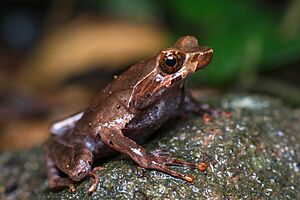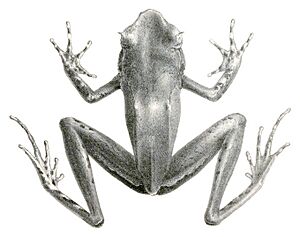Malacca spadefoot toad facts for kids
Quick facts for kids Malacca spadefoot toad |
|
|---|---|
 |
|
| In Khao Sok National Park, Thailand | |
| Conservation status | |
| Scientific classification | |
| Synonyms | |
|
The Xenophrys longipes is a special kind of frog. It belongs to a group of frogs called Megophryidae, often known as horned frogs. People also call this frog by other names, like the Malacca spadefoot toad or the red-legged horn frog.
You can find this frog in Southeast Asia. It lives in the Malay Peninsula, which includes parts of Peninsular Malaysia, southern Thailand, and Burma. Some old reports said it was in Cambodia and Vietnam, but scientists are not sure about those places.
Contents
About the Red-Legged Horn Frog
These frogs have a unique look. Male Xenophrys longipes frogs grow to be about 39 to 47 millimeters long. That's about the length of your thumb! Female frogs are a bit bigger, reaching 49 to 65 millimeters.
Their bodies are quite slim, and they have long back legs. They have a clear eardrum, which is called a tympanum. Their skin on the back is smooth. However, they have small bumps, called warts, on their sides.

What Does It Look Like?
The skin above their eardrum has a clear fold. They also have two pairs of thin, slanted folds on their shoulder area. These folds come together towards the back. The underside of the frog is smooth.
The back of the frog is olive brown. It has dark, slanted bars on the sides of its head. There is also a large, dark triangle shape between its eyes. Its legs have dark stripes across them. The frog's belly is a pale reddish-brown color. It has dark brown spots and patterns, like marble.
Where the Horn Frog Lives
The Xenophrys longipes frog makes its home in special forests. These are evergreen rainforests and cool, misty mountain forests called montane moss forests. During the day, these frogs like to hide. They find shelter under rocks, fallen logs, and other natural spots.
Life in the Stream
When these frogs are young, they are called tadpoles. The tadpoles live in streams. They swim and grow there before they turn into adult frogs.
Protecting the Horn Frog
Even in places where their habitat is perfect, Xenophrys longipes frogs are not very common. This means it can be hard to find them.
Sometimes, these frogs face dangers. One big threat is habitat loss. This happens when forests are cut down for other uses. Losing their forest homes makes it harder for these special frogs to survive.


